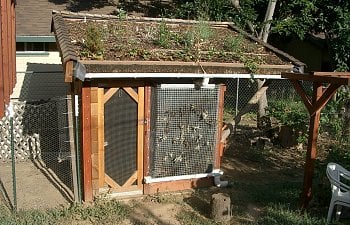Coop de Vie is a living roof/living wall chicken coop. The footprint of the coop is 6' x 7'. The "roofprint" of the coop is 8' x 12'. The slope of the roof is approximately 18-deg. There is an overhang over the southern end of the coop to shade the nest box in summer, yet the intent was to allow for winter time warming (although I don't know if this actually happens...). The main door and the living wall is located on the western face of the coop. The walls are 0.5" plywood with 12"OC 2" x 4" vertical framing on East/West sides and 16"OC 2" x 4" on North/South sides. Three 4' x 8' sheets of 0.75" plywood was used on roof. I framed the roof with 12"OC 2" x 4" as well.
The overall design intent of the coop is the roof first filters the rain water, which then runs over the edge of the coop to a gutter. The gutter then channels this water to living wall. The water drains down the living wall to another gutter, which then drains from the building. This building has been through a few good rain storms, and the design works perfectly. I'm happy. And no leakage inside the structure at all.
The key to successful longevity of the coop is obviously that water does not make extended contact with the wood. I used a pond liner to create a "tub" with 2" x 8" lumber on the sides and top. A 2" x 4" lumber was used on the bottom to offer some structural support. To reduce soil slippage, I used 2" x 6" trex composite decking to form a roughly 2' x 2' grid. This grid also allows for the user to walk on the grid without compacting the soil. Carpet was used on top of the pond liner to prevent damage from a trowel. Soil depth is approximately 5.5". Plants are amazingly well rooted due to carpet, however due to shallow soil, water retention is not so good.
We're growing strawberries and hops along the bottom edge. Californai Native plants are grown on the other sections, along with a few succulents. Succulents are used on the wall, although I need to add more.
One crucial change I would make to this design would be to build it on a more solid foundation. I'm a biological systems engineer and mechanical engineer by training, and paid little attention to the importance of a foundation!!! But I was accused of overbuilding the coop structure (I still feel my design was adequate!). The foundation I used was broken concrete chunks "leveled" (and they were level) on crushed dirt.... I was thinking the coop would settle evenly...but alas. The settling is just ever so off too, really only I would notice.

